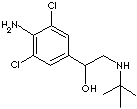|
CLENBUTEROL HYDROCHLORIDE |
|
4-Amino-alpha-((tert-butylamino)methyl)-3,5-dichlorobenzyl alcohol hydrochloride; 4-Amino-alpha-((tert-butylamino)methyl)-3,5-dichlorobenzylalkohol-hydrochlorid; Clenasma; Clenbuterol HCl; Clenbuterol clorhidrato; Contrasmina; Monores; Planipart hydrochloride; Spiropent; Ventipulmin; |
|
|
| PRODUCT IDENTIFICATION |
|
|
CAS RN |
37148-27-9 (parent), 21898-19-1; 53144-57-3 (hydrochloride) |
|
EINECS RN |
244-643-7 |
|
FORMULA |
C12H18Cl2N2O·HCl |
|
MOLE WEIGHT |
313.65 |
|
CHEMICAL FAMLY |
Phenylaminoethanol |
|
CATEGORY |
beta2-Adrenoceptor agonist, Bronchodilator |
|
|
| PHYSICAL AND CHEMICAL PROPERTIES |
|
|
PHYSICAL STATE |
white to off-white crystalline powder |
|
MELTING POINT |
172-176 C |
|
BOILING POINT |
|
|
DENSITY |
|
|
SOLUBILITY IN WATER |
Soluble (Soluble in alcohol, slightly soluble in acetone) |
|
pH |
|
|
VAPOR DENSITY |
|
|
REFRACTIVE INDEX |
|
|
FLASH POINT |
|
|
|
| STABILITY AND REACTIVITY | |
| STABILITY | Stable under normal conditions. |
|
INCOMPATIBILITIES |
Strong oxidizing agents |
|
DECOMPOSITION PRODUCTS |
Carbon oxides, nitrogen oxides, Hydrogen chloride gas |
| POLYMERIZATION | Has not been reported |
|
TOXICOLOGICAL NOTE |
LD50 Oral rat: 159 mg/kg |
|
|
| SAFETY NOTES |
|
|
HAZARD OVERVIEW |
Toxic if swallowed. |
|
EYE |
May cause eye irritation |
|
SKIN |
May cause skin irritation. May be harmful if absorbed through skin. |
|
INGESTION |
Toxic if swallowed. |
|
INHALATION |
May be harmful if inhaled. May cause respiratory tract irritation. |
|
CHRONIC |
|
|
|
| TRANSPORT & REGULATORY INFORMATION |
|
|
UN NO. |
2811 |
| HAZARD CLASS |
6.1 |
| PACKING GROUP |
III |
| HAZARD SYMBOL |
T |
|
RISK PHRASES |
25 |
|
SAFETY PHRASES |
22-36/37-45 |
|
|
| GENERAL DESCRIPTION & EXTERNAL LINKS |
||
|
Wikipedia Linking: http://en.wikipedia.org/wiki/Clenbuterol The most important action of clenbuterol and other beta2-agonists in the lung is relaxation of airway smooth muscle. For this reason, such drugs are widely used for relief of bronchospasm in human asthma and similar diseases in animals. When these drugs bind to b2-adrenoceptors, they activate adenylyl cyclase, which leads to an increase in the intracellular concentration of the second messenger cyclic adenosine monophosphate (cAMP) and activation of protein kinase A (PKA). In the tracheobronchial tree and in the uterus, b2-agonists, cAMP, and PKA inhibit smooth muscle contraction by opening K1 channels and by down-regulation of myosin light chain kinase activity. )http://www.ivis.org/) Clenbuterol is classed as a 'beta-2 agonist' and its short-term effects are similar to stimulant drugs like amphetamine or ephedrine (i.e. increases heart rate, temperature, perspiration and blood pressure). The main therapeutic use of clenbuterol is in the treatment of asthma to relax the smooth muscle in the airways. Clenbuterol is also used as a bronchodilator in veterinary medicine. Clenbuterol produced for human consumption is generally in tablet form. The most common veterinarian preparation is a syrup. Clenbuterol is not approved for human use in Australia and is also banned under the Olympic Movement's World Anti-Doping Code Prohibited Classes of Substances and Prohibited Methods. Clenbuterol is being used alone and in conjunction with other substances to promote the growth of skeletal muscle ('anabolic effects') and to reduce body fat ('catabolic effects'). Some athletes and body builders are using clenbuterol without proof of its effectiveness or safety. Some animal studies have shown that using a stimulant like clenbuterol has the 'anabolic effect' of increasing muscle mass and body weight by enhancing muscle protein synthesis in rodents. However, no human studies are available on whether clenbuterol can increase strength or power. Body builders and athletes most often utilise clenbuterol as a 'fat burner' to 'define' muscles (i.e. for its 'catabolic effect'). Clenbuterol has the ability to slightly increase the body's core temperature and metabolism, which users believe assists in the burning of calories. The body will fight this effect however, so clenbuterol may only have an effect over a limited time period. (http://ndarc.med.unsw.edu.au/) A substituted phenylaminoethanol that has beta-2 adrenomimetic properties at very low doses. It is used as a bronchodilator in asthma.
|
|
|
| SALES SPECIFICATION |
|
|
APPEARANCE |
white to off-white crystalline powder |
|
IDENTIFICATION |
pass Test 1,2,3,4,5 |
|
ASSAY |
98.0% min |
|
SOLUTION CLARITY |
not more opalescent than reference suspension and not more intensely colored than reference solution Y6 |
|
MELTING POINT |
172-176 C |
|
WATER |
1.0% |
|
SPECIFIC ROTATION |
-0.1° ~ +0.1° |
|
SULFATED ASH |
0.1% max |
|
pH |
5 - 7 |
|
LOSS ON DRYING |
0.5% max |
|
CHLORINITY |
32.5%-35.0% |
|
HEAVY METALS |
10ppm max |
|
|
| PACKING |
|
|
|
|
| PRICE |
|
|
